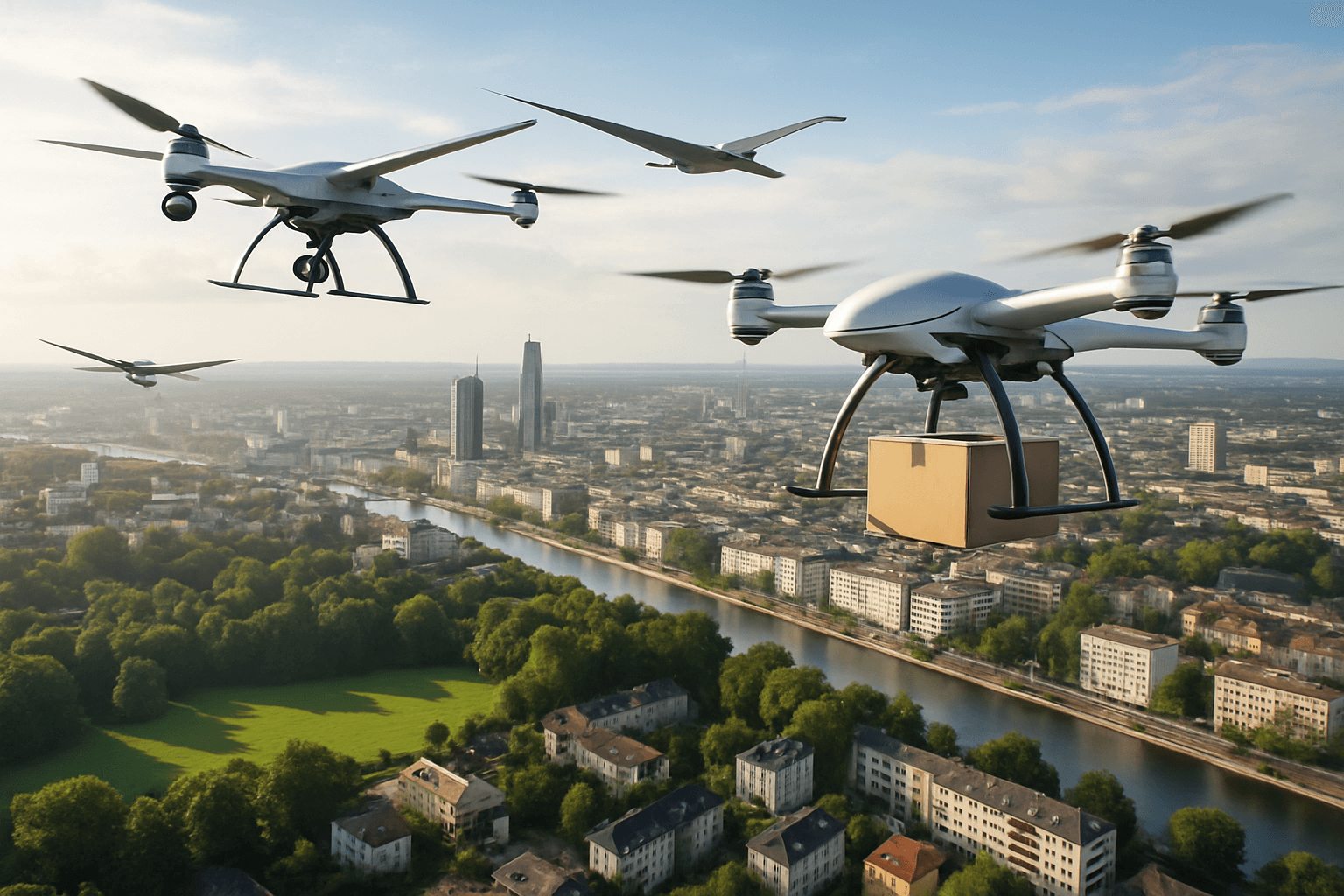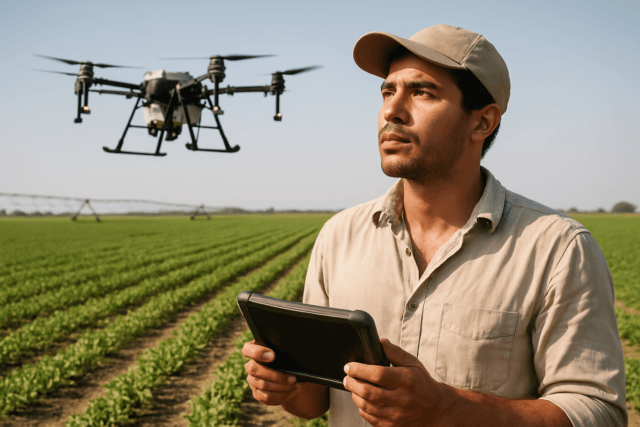The drone market is experiencing significant growth globally, with Europe playing a crucial role in this expansion. Drones, also known as unmanned aerial vehicles (UAVs), are transforming various industries, from agriculture and construction to security and logistics. This article delves into the current state of the drone market in Europe, explores its growth drivers and challenges, and examines its potential future impact.
Why Europe’s Drone Market Is Taking Off
Several factors contribute to the increasing popularity of drones in Europe:
- Versatile Applications: Drones are finding enhanced applications in commercial uses, such as in the construction sector, allowing building managers to meet project deadlines more efficiently. They are also used for scanning construction sites and overseeing the entire construction lifecycle.
- Technological Advancements: Advancements in electronics and payload technologies are supporting market growth. Drone manufacturing companies are catering to diversified use cases such as agriculture, data collection, aerial photography, surveys, and wildlife documentation.
- Recreational Use: The recent trend of using drones for recreational purposes is expected to support market growth in the short term. They are used for drone-enabled firework displays and capturing dramatic cinematic views.
- Government Support: Supportive government initiatives and increasing use of drone technologies in construction projects boost market expansion in the long run.
- Evolving Regulations: The European Union Aviation Safety Agency (EASA) is implementing comprehensive regulations to ensure Europe remains at the forefront of drone use. These regulations, effective January 1, 2024, classify drones into open, specific, and certified categories, each with unique operational limitations and compliance requirements.
Drone Market Size and Growth in Europe
The European drone market is experiencing substantial growth, with projections indicating continued expansion in the coming years. Several sources offer different estimations:
- Fact.MR: Projects the European market to reach $45.96 billion by 2034, with a CAGR of 26%. They estimate the market value at $4.56 billion for 2024.
- Market Data Forecast: Estimates the European market size at $4.50 billion in 2024, expecting it to reach $5.60 billion in 2025 and $32.34 billion by 2033, with a CAGR of 24.50%.
- Europe Commercial Drones Market Analysis: The Europe Commercial Drones Market size is estimated at USD 7.29 billion in 2025 and is expected to reach USD 13.16 billion by 2030, at a CAGR of 12.54% during the forecast period.
- Grand View Research: Estimates the Europe commercial drone market at $5.90 billion in 2023, projecting a growth to $13.56 billion by 2030 with a CAGR of 12.6% from 2024 to 2030.
- Horizon Databook: Reports a revenue of $17,051.4 million in 2024 and expects the market to grow at a CAGR of 13.4% from 2025 to 2030, reaching a projected revenue of $36,337.3 million by 2030.
- Europe Autonomous BVLOS Drone Market: Europe autonomous BVLOS drone market was valued at US$ 3,447.0 million in 2023 and is projected to surpass a valuation of US$ 14,828.8 million by 2032, growing at a CAGR of 17.6% during the forecast period of 2024–2032.
- Europe Drones Market: The Europe Drones Market Size was estimated at 7.4 (USD Billion) in 2023. The European drone market is expected to grow from 7.4 (USD Billion) in 2024 to 32.2 (USD Billion) by 2035. The Europe Drones Market CAGR (growth rate) is expected to be around 14.3% during the forecast period (2025 – 2035).
These figures highlight the strong growth potential of the drone market in Europe, driven by technological advancements, increasing applications, and supportive regulatory frameworks.
Key Market Segments
The drone market can be segmented based on various factors, including component, type, range, and application.
- By Component: The hardware segment is the dominant revenue generator, driven by continuous advancements in drone technology. The services segment is also experiencing rapid growth due to the increasing demand for aerial photography and videography.
- By Type: Mid-range UAVs accounted for the highest revenue in 2023, suitable for meteorological data gathering, surveillance, and border security. Small UAVs are also popular, especially among amateurs and aerial photographers, due to their versatility.
- By Range: Drones with shorter endurance (less than 5 hours) currently hold the largest market share, while the 5-10 hours segment is anticipated to grow at the fastest CAGR.
- By Application: The military and defense sector currently leads in revenue, with autonomous BVLOS drones extensively used for aerial combat, surveillance, and reconnaissance. However, commercial applications such as construction, agriculture, and logistics are also significant drivers of market growth.
Drone Applications Across Industries
Drones are being utilized across a wide array of industries, demonstrating their versatility and potential:
- Agriculture: Drones are used for crop monitoring, optimizing irrigation, and increasing yields. In Spain, drones have helped reduce pesticide usage by 40%. The EU’s Common Agricultural Policy (CAP) incentivizes drone use through subsidies.
- Construction: Drones scan construction sites and oversee the entire lifecycle, helping building managers meet project deadlines efficiently. AI-powered drones in construction workflows are expected to increase productivity by 35% by 2025.
- Logistics and Delivery: Drones are being tested and piloted for delivery services in countries like the UK. The delivery and logistics segment is expected to witness the fastest CAGR due to the expansion of e-commerce.
- Security and Surveillance: Drones are deployed for security monitoring, safety inspections, and surveillance, driven by increasing government permissions for BVLOS operations in the commercial sector.
- Urban Air Mobility (UAM): Cities like Paris and Hamburg are investing in drone-based transportation systems, with the UAM market in Europe projected to reach $4.2 billion by 2030.
- Environmental Monitoring: Drones contribute to environmental protection, agriculture, forestry, meteorology, and natural disaster response.
- Emergency Services: Drones can be used for emergency services, mapping, imaging, inspection, and surveillance, as well as urgent delivery of small consignments like biological samples or medicines.
Regulatory Landscape in Europe
The regulatory landscape for drones in Europe is evolving, with the European Union Aviation Safety Agency (EASA) playing a key role in establishing common rules and standards.
- EASA Regulations: EASA establishes common rules and standards for civil aviation safety across EU Member States, including drones since 2018. These regulations cover certification, operational requirements, and safety standards.
- National Regulations: Each EU and European Free Trade Association (EFTA) member state may have additional regulations specific to their jurisdiction, which must align with EASA regulations.
- EU Drone Strategy 2.0: The European Commission adopted the European Drone Strategy 2.0 in November 2022 to further develop the drone market, aiming to implement financial, technical, and operational actions to foster the right commercial and regulatory environment.
- Drone Categories: Drones are classified into open, specific, and certified categories, each with unique operational limitations and compliance requirements.
- Mandatory Registration and Identification: Remote Identification for Drones became mandatory starting January 1, 2024, enhancing airspace safety and accountability across the EU.
Challenges and Opportunities
Despite the promising growth prospects, the drone market faces several challenges:
- Regulatory Hurdles: Stringent regulations and the slow pace of drone regulation development, particularly regarding BVLOS operations and autonomous flight, create operational barriers.
- Technological Limitations: Limited battery life, range, and payload capacity can restrict the scope and duration of drone missions.
- Social Apprehension: Addressing concerns over privacy, safety, and security is crucial for gaining public acceptance.
- Infrastructure Inadequacies: Existing air traffic management systems are designed for manned aircraft and lack the capabilities to safely integrate large numbers of autonomous drones. The lack of landing and charging stations also poses a challenge.
- Funding and Investment: Commercial drone funding remains a central challenge, with investments declining in recent years.
However, these challenges also present opportunities for innovation and strategic development:
- Technological Advancements: Continued investment in research and development can lead to breakthroughs in battery technology, autonomous systems, and sensor capabilities.
- Regulatory Harmonization: Collaboration between regulatory bodies, drone manufacturers, and other stakeholders is essential to establish clear and harmonized rules, ensuring safe and efficient integration of BVLOS drones into European airspace.
- Strategic Positioning: Players need to think about their strategic positioning, the type of drones to be used according to the application, and the associated technical characteristics.
- Market Consolidation: Companies are reassessing their strategies to ensure long-term sustainability amid challenges such as regulatory hurdles, scalability, and shifts in investment focus.
Leading Companies in the European Drone Market
The European drone market is fragmented, with several players accounting for significant shares:
- Azure Drones SAS
- Parrot Drones SAS
- Terra Drone Corporation
- Onyx Scan Advanced LiDAR Systems
- AltiGator (Amphios s.r.l./b.v.a)
- Baykar
- Leonardo
The Future of Drones in Europe
The future of the drone market in Europe looks promising, with increasing integration of drones across various sectors and continuous technological advancements.
- Expansion of Applications: Drones will continue to find new applications in agriculture, construction, logistics, security, and urban air mobility.
- Focus on Sustainability: Drones will play a crucial role in achieving the goals of the European Green Deal, contributing to a resource-efficient, competitive, and modern economy.
- Urban Air Mobility: Urban air mobility (UAM) in Europe is a significant opportunity for the Europe drone market, with cities like Paris and Hamburg investing heavily in drone-based transportation systems.
- Government Support: Supportive government policies and funding mechanisms will continue to drive market growth.
- Strategic Alliances: Turkish-Italian ventures and other strategic alliances are adding new forces to Europe’s drone market.
Conclusion
The drone market in Europe is poised for substantial growth, driven by versatile applications, technological advancements, and evolving regulations. While challenges remain, ongoing innovation and strategic collaborations are paving the way for a future where drones are seamlessly integrated into various aspects of European life. As the market continues to evolve, stakeholders must address regulatory hurdles, technological limitations, and social apprehensions to fully unlock the potential of drones and ensure their safe and responsible deployment. With a clear vision and collaborative efforts, Europe can solidify its position as a global leader in the drone revolution.





